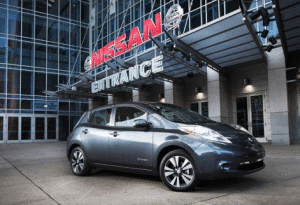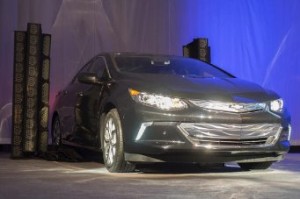by Jon LeSage, editor and publisher, Green Auto Market
Here’s my take on the 10 most significant and interesting occurrences during the past week…….
 Leaf takes the top spot. Not long ago, cleantech analysts thought plug-in hybrids would dominate the US market over battery electric vehicles. Yet, the Nissan Leaf continues to hold the top spot and just reached another benchmark – 30,200 units sold in the US last year, a new record. That makes for a total of 72,322 sold in the US since the launch in December 2010 through the end of 2014. The Leaf leads a market trend where three of the leading electric models are now selling over 1,000 units a month in the US, with the Chevrolet Volt and Tesla Model S following right behind. During some months in the past, other models have surpassed the 1,000 mark – the Toyota Prius Plug-In, Ford C-Max Energi, and the Ford Fusion Energi.
Leaf takes the top spot. Not long ago, cleantech analysts thought plug-in hybrids would dominate the US market over battery electric vehicles. Yet, the Nissan Leaf continues to hold the top spot and just reached another benchmark – 30,200 units sold in the US last year, a new record. That makes for a total of 72,322 sold in the US since the launch in December 2010 through the end of 2014. The Leaf leads a market trend where three of the leading electric models are now selling over 1,000 units a month in the US, with the Chevrolet Volt and Tesla Model S following right behind. During some months in the past, other models have surpassed the 1,000 mark – the Toyota Prius Plug-In, Ford C-Max Energi, and the Ford Fusion Energi.- GM Ventures backs another startup. General Motors plans to increase fuel economy on some of its models up to 15% using a new cylinder deactivation technology. Dynamic Skip Fire, or DSF, ignition system technology integrates advanced digital signal processing and software; the cylinders are programmed to only fire and deliver performance as the driver needs, saving on fuel. DSF is being developed by Tula Technology, Inc; that company received funding from GM Ventures in 2012. GM Ventures, led by Jon Lauckner, GM’s VP of global R&D, has lead investments in about 20 start-up advanced vehicle technology companies. (Read more about the role GM Ventures and others are doing in clean transportation funding in a special feature for this week.)
- Connected cars take lead at CES. Those attending Consumer Electronics Show (CES) in Las Vegas starting today will get to see that connected cars with advanced technologies are cooler this year than video games. Ford CEO Mark Fields will be delivering a keynote speech on the dawn of the connected car era. Daimler CEO Dieter Zetsche will be speaking about a self-driving Mercedes-Benz model. Volkswagen is making its debut at CES and will be joined by industry colleagues Toyota, General Motors, Hyundai, Mazda, Audi, BMW, and FCA US LLC (which was not long ago known as Chrysler Group).
- Bad news for workaholics: Starting up and running an electric carmaker and space flight company might mean you can’t stay married. Tesla CEO Elon Musk filed for divorce on New Year’s Eve for the second time with British actress Talulah Riley. They’d married in 2010, divorced, and remarried in 2013. That followed a previous marriage with five children (including triplets) to Canadian-born science fiction writer Justine Musk. It sounds like that divorce in 2010 wasn’t as friendly as the latest two with Talulah Riley, as would be assumed. (Editor’s Note: Watch the 2011 film “Revenge of the Electric Car” if you want to catch a glimpse of Musk’s previous family life.)
- Diesel is still a bit pricy: Natural gas vehicle sales have been feeling the impact of gasoline prices coming down strong in the past six months. Natural gas has a better shot at competing directly with diesel-powered trucks, according to Erik Neandross, CEO of Gladstein, Neandross & Associates (GNA), a consulting firm and organizer of ACT Expo. National average pricing for diesel has been staying around $3.40 to $3.50 per gallon – “by no means a bargain,” Neandross said during a recent webinar.
- OEMs haven’t abandoned EVs: Automotive News doesn’t see automakers walking away from electric vehicles (EVs) as gasoline prices continue to stay down. The investment in the technology continues……. GM is rolling out its NextGen Chevrolet Volt (read all about it in a feature for this week); the automaker also plans to roll out an electric 2017 Chevrolet Sonic. Volkswagen invested in a 5% stake in Silicon Valley-based battery developer QuantumScape Corp., with its stable solid state battery technology. Nissan claims that it will roll out a second-generation battery that will double the range of the Leaf from its present EPA estimated 84 mile maximum. Tesla Motors is moving forward on its “gigafactory,” recently starting recruitment of its first 300 workers for its Sparks, Nev., facility.
- Clean Energy sells its stake in biomethane company. Clean Energy Fuels Corp., based in Newport Beach, Calif., has sold its majority stake in a Dallas-based biomethane production facility to a minority owner for $40.6 million. The sale goes to Cambrian Energy Development LLC, based in Los Angeles, which has been a partner with Clean Energy since 2008. At that times the two companies jointly acquired the McCommas Bluff facility, the third-largest landfill gas operation in the US.
- Porsche marketing chief loves plug-in hybrids. Bernhard Maier, Porsche’s global sales and marketing executive, is getting a kick out of driving a Porsche Panamera and Cayenne to work each day. He’s able to stay almost entirely on electric power during his 25 mile trip. He’s becoming a true believer in plug-in hybrids – one of the reasons is enjoying the convenience of having your own filling station at home or the office
- Toyota opening up on hydrogen technology. Toyota Motor Corp. said it won’t be enforcing more than 5,600 patents it holds on its hydrogen fuel-cell technology through 2020. Competitors are free to use that technology, which falls in line with steps taken last year by Tesla Motors to encourage carmakers to tap into its battery technologies to spur adoption of battery electric vehicles.
- ChargePoint rolls out home charging system. Campbell, Calif.-based ChargePoint is now offering what it calls the “world’s most attractive and advanced EV charging station.” ChargePoint Home offers speed, convenience, and intelligence to EV drivers. Drivers will be able to charge up to 25 miles per hour and easily manage the charger from their smartphone. It’s being displayed at booth #2815 at the Las Vegas Convention Center as part of the Consumer Electronics Show.


